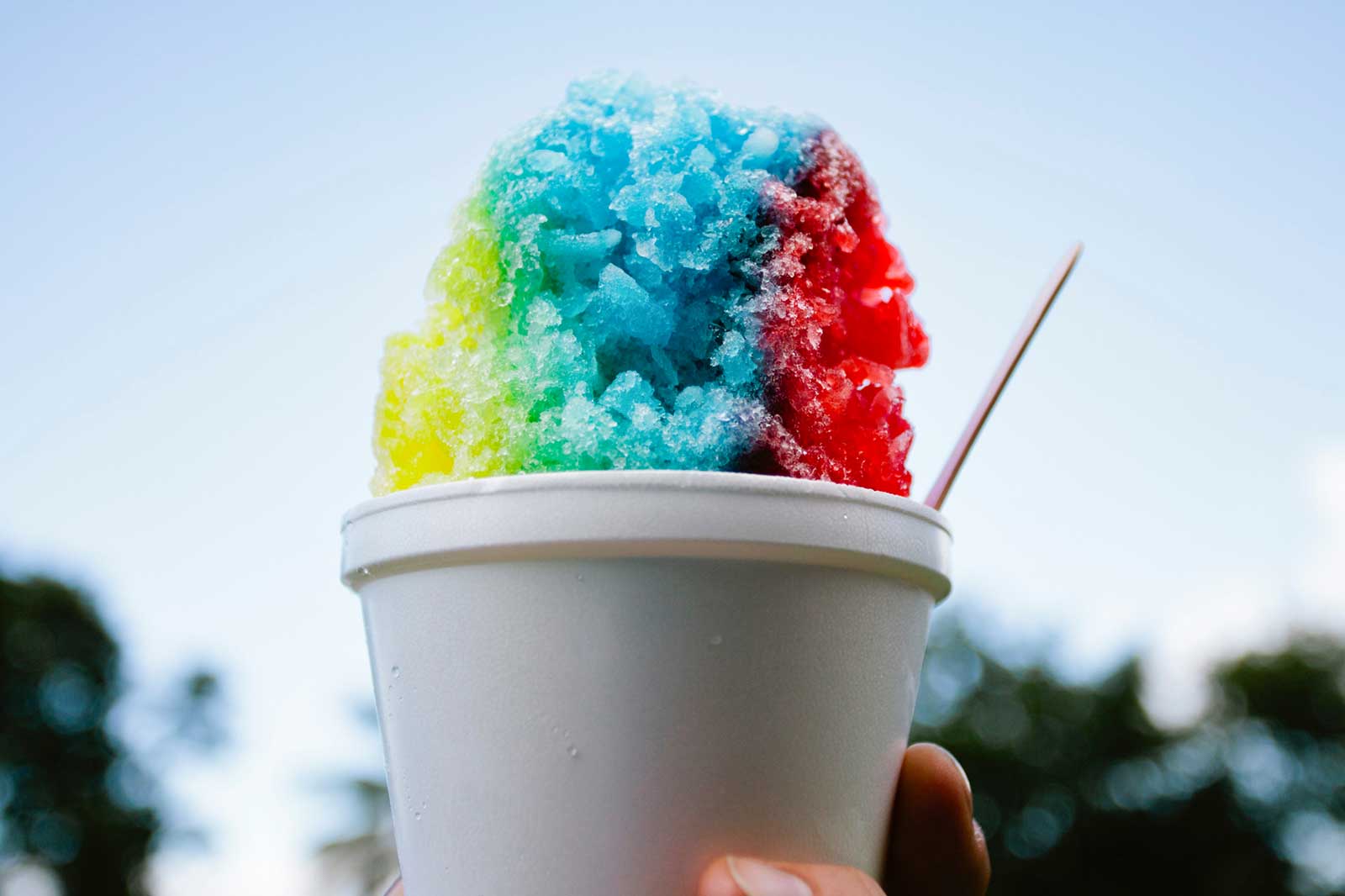Introduction:
Snow cones, those whimsical and colorful icy treats, have been a source of joy for generations, offering a delightful respite from the scorching heat of summer. These frozen wonders, often found at fairs, carnivals, and neighbourhood stands. They have become a cherished part of the warm-weather experience. In this article, we’ll embark on a frosty journey exploring the history, varieties, and cultural significance of snow cones, discovering why these simple frozen delights continue to captivate both the young and the young at heart.
The Origins of Snow Cones: A Chill Through History:

The history of snow cones can be traced back to ancient times, where various cultures experimented with combining ice and Flavors to create refreshing concoctions. However, it wasn’t until the 19th century that the snow cone, as we know it today, began to take shape.
The earliest version of the snow cone can be credited to Samuel Bert of Dallas, Texas. In 1919. Bert designed and patented a simple but ingenious ice-crushing machine, laying the foundation for the widespread popularity of snow cones. Bert’s creation allowed for the efficient transformation of ice into delicate, fluffy snow, setting the stage for the evolution of this frozen treat.
Evolution of the Ice-Flavoured Delight: From Snowballs to Snow Cones
As snow cones gained popularity, regional variations and unique twists emerged, adding layers of creativity to this frozen delight. For instance, in Baltimore, Maryland, the “snowball” became a local favorite. It typically features finely shaved ice topped with flavored syrups and often with the addition of marshmallow cream for an extra touch of sweetness.
On the West Coast, particularly in Southern California, raspados gained prominence as a Mexican version of shaved ice. Known for their vibrant colors and diverse range of toppings, raspados include fresh fruit, condensed milk, and even a sprinkle of chili powder. This creates a harmonious blend of sweet, tart, and spicy flavors.
The transition from snowballs to snow cones is marked by the advent of the paper cone and which provided a more convenient and portable way to enjoy the icy delight. The iconic image of a brightly colored cone brimming with fluffy shaved ice embodies the quintessential snow cone experience.
Cool Creations: The Art of Flavouring Snow Cones:

One defining feature of snow cones is the myriad of flavors infused into the ice. The flavoring process involves drizzling vibrant, often neon-hued syrups over the shaved ice, delicious essence. Flavor options are virtually limitless, ranging from classic fruit flavors like cherry and blue raspberry and passion fruit.
In recent years, gourmet snow cones have surged in popularity. With artisanal syrups crafted from high-quality ingredients elevating the flavor profile. Unique combinations such as lavender lemonade, cucumber mint, and hibiscus ginger have transformed the humble snow cone.
Snow Cones Around the World: A Global Chill:

While snow cones have deep roots in American culture, variations of this icy indulgence can be found around the world. In Japan, kaki Gori takes the spotlight, featuring finely shaved ice flavored with syrup and condensed milk. Kaki Gori often incorporates traditional Japanese ingredients like matcha (green tea powder) and anko creating a delightful fusion of flavors.
Transitioning to the Philippines, halo-halo, meaning “mix-mix,” offers a unique take on shaved ice. This elaborate dessert combines shaved ice with a medley of ingredients such as sweetened fruits, jellies, leche flan (caramel custard), and ube (purple yam) ice cream. The result is a colorful and refreshing masterpiece that reflects the vibrant culinary landscape of the Philippines.
The Cultural Significance of Snow Cones: More Than Just a Frozen Treat:
Beyond their delectable taste, snow cones hold cultural significance and play a role in various celebrations and traditions. In many communities, snow cones evoke nostalgia and joy, particularly at summer fairs. They are also a staple at beach outings, offering a cool treat to beat the heat.
Snow cones have become integral to the cultural fabric of New Orleans, especially during Mardi Gras season. The local variation, known as “sno-ball,” features finely shaved ice topped with an array of syrup flavors. Enjoying a sno-ball has become a cherished ritual for locals and visitors alike, adding a sweet touch to the vibrant festivities of Mardi Gras.
Healthier Twists on Snow Cones: Catering to Modern Tastes:

As society becomes more health-conscious, the demand for healthier alternatives to traditional snow cones has grown. Society’s health consciousness drives demand for healthier snow cone alternatives. Vendors offer sugar-free syrups and natural fruit juices. Health-focused establishments provide shaved ice desserts with fresh fruit toppings.
The Joyful Experience of Making Snow Cones at Home:
In the age of do-it-yourself culinary adventures, making snow cones at home has become a popular and enjoyable activity for families. Home snow cone machines allow individuals to experiment with Flavors, create custom syrup combinations and even incorporate fresh fruit purees for a burst of natural sweetness. This DIY approach not only adds a personal touch to the snow cone experience but also provides a fun and interactive way for families to bond.
Snow Cones in Pop Culture: From Cartoons to Blockbusters:
Snow cones have left an imprint on popular culture, making appearances in various forms of entertainment. From animated characters enjoying colorful snow cones on Saturday morning cartoons to iconic scenes in movies featuring friends sharing a snow cone at the boardwalk, this frozen treat has become a symbol of carefree moments and simple pleasures.
In the 1980s classic “The Goonies,” a group of adventurous kids embarks on a treasure hunt, with a memorable scene showcasing the delight of enjoying snow cones after unearthing a secret underground passage. This cinematic moment captured the essence of childhood camaraderie and the joy of savoring a sweet, icy treat on a hot summer day.
Also read this” Sarape: A Vibrant Tapestry of Mexican Culture “
Conclusion:
In conclusion, the world of snow cones offers a vibrant and ever-evolving landscape that spans cultures, flavors, and generations. From its humble beginnings as a shaved ice treat in the heat of a Texan summer to its global variations and gourmet transformations, snow cones continue to captivate taste buds and bring smiles to faces.
Whether enjoyed at a local fair, crafted with artisanal syrups, or savored at home with loved ones, snow cones remain symbols of refreshment, simplicity, and the joys of summer. As we navigate the diverse and delightful universe of snow cones, let us savor the sweetness of these frozen wonders and appreciate the cultural richness they bring to our lives. So, the next time you hear the familiar jingle of a snow cone truck or feel the crunch of finely shaved ice against your tongue, take a moment to revel in the cool bliss of this timeless frozen delight.
FAQs:
1. What is the origin of snow cones, and how did they evolve into the frozen treats we enjoy today?
Snow cones have a fascinating history, tracing back to ancient times. The modern version began shaping in the 19th century. Samuel Bert of Dallas, Texas, patented an ice-crushing machine in 1919. This invention laid the foundation for snow cones’ widespread popularity.
The transition from snowballs to snow cones marked the advent of the paper cone. It offered a more convenient and portable way to enjoy the icy delight.
2. How have snow cones evolved globally, and what are some unique variations found in different cultures?
Snow cones have taken on various forms around the world, showcasing creativity and flavor diversity. In Japan, kaki Gori features finely shaved ice flavored with syrup and condensed milk, often incorporating traditional Japanese ingredients like matcha. In the Philippines, halo-halo is a popular shaved ice dessert with a mix of sweetened fruits, jellies, and ube ice cream. Exploring these global variations adds an exciting dimension to the enjoyment of snow cones.
3. What role do snow cones play in cultural traditions and celebrations, especially in regions like New Orleans during Mardi Gras?
Snow cones hold cultural significance, becoming integral to various celebrations and traditions. Additionally, in New Orleans, especially during Mardi Gras, the local variation known as “sno-ball” has become a cherished part of the festivities. Furthermore, the joy of enjoying a sno-ball has become a ritual for both locals and visitors, adding a sweet touch to the vibrant celebrations of Mardi Gras.










